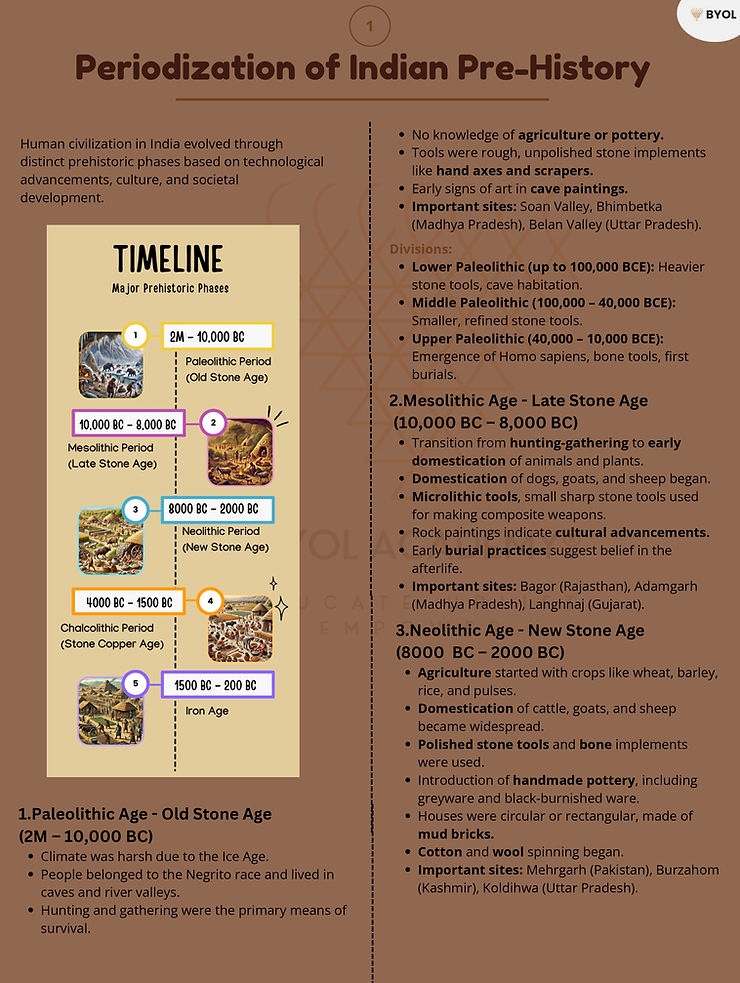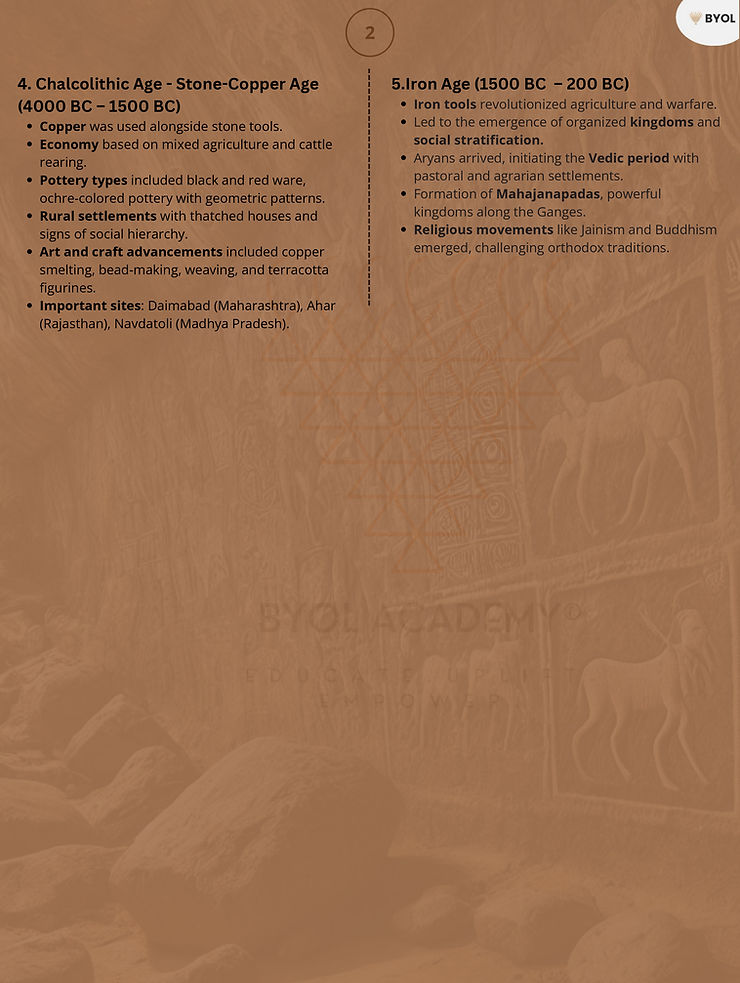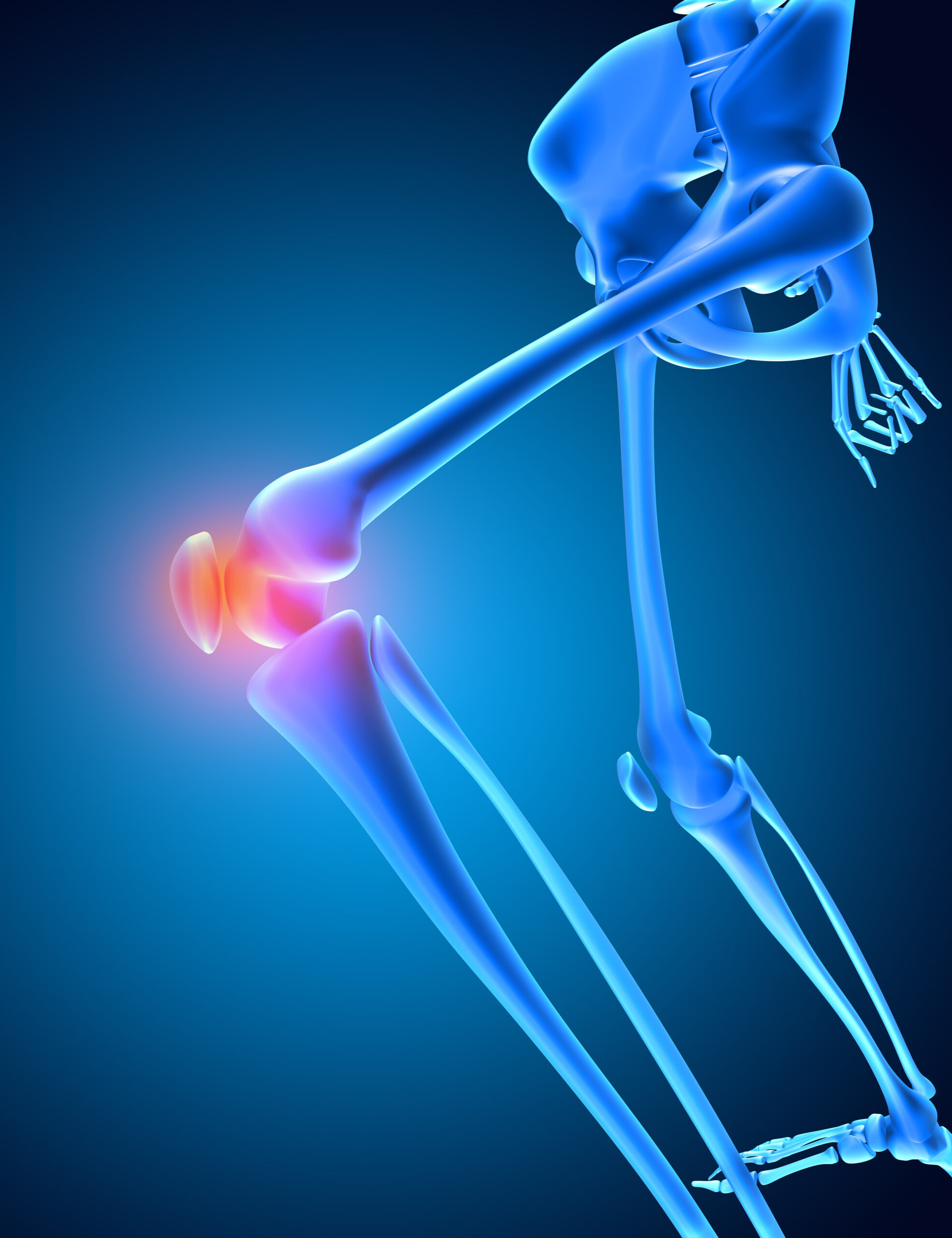Human civilization in India evolved through distinct prehistoric phases, each marked by advancements in tools, culture, and societal structure. The journey from primitive hunter-gatherers to settled agriculturalists and early metal users was a transformative one.
According to the technologies that people utilized in those times, ancient history can be categorized into distinct periods –
| Paleolithic Period (Old Stone Age): | 500,000 BCE – 10,000 BCE |
| Mesolithic Period (Late Stone Age): | 10,000 BCE – 6000 BCE |
| Neolithic Period (New Stone Age): | 6000 BCE – 1000 BCE |
| Chalcolithic Period (Stone Copper Age): | 3000 BCE – 500 BCE |
| Iron Age: | 1500 BCE – 200 BCE |
The Stone Age: Foundation of Civilization
The use of stone tools and lacking a written script were hallmarks of the Stone Age, which lasted for several millennia. Archaeological investigations into this age were made possible by Robert Bruce Foote’s discovery of the Pallavaram hand axe in India. The Stone Age can be roughly divided into:
Paleolithic Age (Old Stone Age) (500,000 BCE – 10,000 BCE)
This phase coincided with the Ice Age, making survival a constant struggle. The people belonged to the ‘Negrito’ race, living in caves, open fields, and river valleys. Key characteristics include:
| Subsistence: | Hunting, food gathering; no knowledge of pottery or agriculture. |
| Tools: | Rough, unpolished stone tools like hand axes, choppers, and scrapers made of quartzite. |
| Cultural Aspects: | Evidence of early art forms in later stages. |
| Key Sites: | Soan Valley, Belan Valley (UP), Bhimbetka (MP), and the Deccan Plateau. |
Divisions:
- Lower Paleolithic (up to 100,000 BCE): Heavier tools, habitation in caves.
- Middle Paleolithic (100,000 – 40,000 BCE): Smaller, lighter tools like blades and scrapers.
- Upper Paleolithic (40,000 – 10,000 BCE): Homo sapiens emerge; tools made of bones; first signs of burials.
Mesolithic Age (Late Stone Age) (10,000 BCE – 6000 BCE)
This period witnessed a shift towards a settled lifestyle as the climate warmed.
| Subsistence: | Transition from hunting-gathering to early domestication of animals (dogs, goats, sheep) and plant cultivation. |
| Tools: | Microliths—miniature, sharp stone tools used for composite weapons. |
| Cultural Developments: | Rock paintings in Bhimbetka; burial practices showing belief in afterlife. |
| Key Sites: | Bagor (Rajasthan), Adamgarh (MP), Langhnaj (Gujarat), and Ezhuthu Guha (Kerala). |
Neolithic Age (New Stone Age) (6000 BCE – 1000 BCE)
This was a revolutionary phase that set the foundation for civilization. Agriculture and domestication of animals became widespread.
| Subsistence: | Cultivation of wheat, barley, rice, and pulses; domestication of cattle, goats, and sheep. |
| Tools: | Polished stone tools and bone implements. |
| Pottery: | Hand-made greyware, black-burnished ware, later using foot wheels. |
| Housing: | Circular or rectangular mud houses; spinning of cotton and wool. |
Key Sites:
- Mehrgarh (Pakistan): Early farming and sun-dried brick houses.
- Burzahom (Kashmir): Pit dwellings and domesticated dogs.
- Koldihwa (UP): World’s oldest evidence of rice cultivation.
Chalcolithic Age (Stone-Copper Age) (3000 BCE – 500 BCE)
The use of copper alongside stone tools marked the Chalcolithic period, laying the foundation for metal-based civilizations.
| Subsistence: | Mixed economy of agriculture and cattle rearing; domestication of sheep, goats, and buffalo. |
| Pottery: | Black and red pottery, ochre-colored pottery with geometric designs. |
| Settlements: | Rural, thatched houses made of mud bricks; the emergence of social hierarchy. |
| Art and Craft: | Copper smelting, bead-making, weaving, and terracotta figurines of Mother Goddess. |
Key Sites:
- Daimabad (Maharashtra): Bronze artifacts including a rhinoceros and chariot.
- Ahar (Rajasthan): Copper metallurgy and rice cultivation.
- Navdatoli (MP): Large settlements cultivating diverse crops.
Iron Age (1500 BCE – 200 BCE): The Rise of Complex Societies
The use of iron tools revolutionized agriculture and warfare, leading to organized kingdoms and social stratification.
| Arrival of Aryans: | Vedic period began with extensive pastoral and agrarian settlements. |
| Formation of Mahajanapadas: | Powerful kingdoms emerged along the Ganges, shaping India’s future socio-political landscape. |
| New Religious Movements: | Jainism and Buddhism arose, challenging orthodox traditions. |
Conclusion
During the Prehistoric era throughout India, civilization developed gradually but steadily. These changes, from hunting to settled agriculture, stone tools to iron weapons, set the groundwork for India’s rich and varied history. The advent of organized societies that would eventually determine historical India resulted from new technology and cultural developments brought about by each era.






